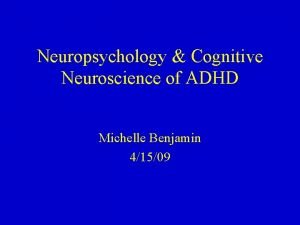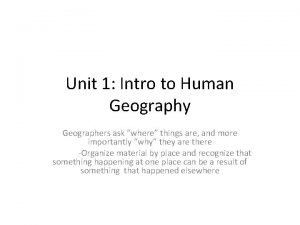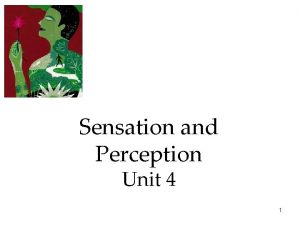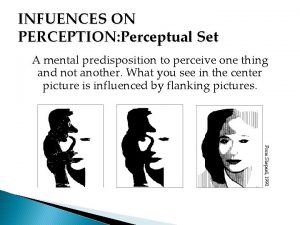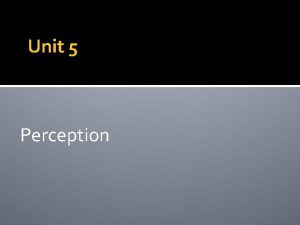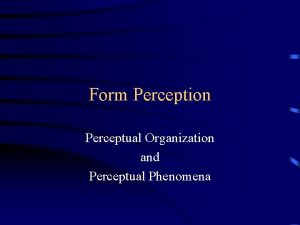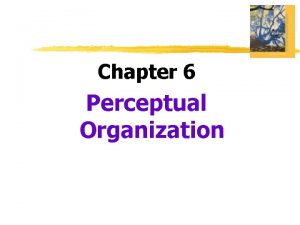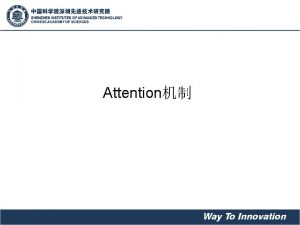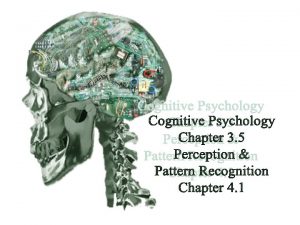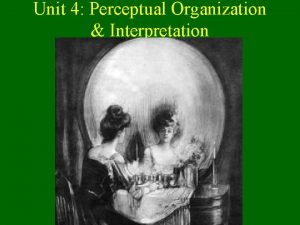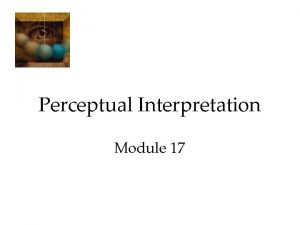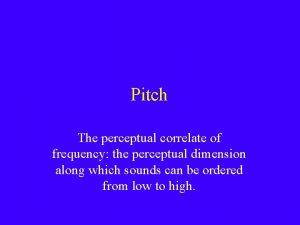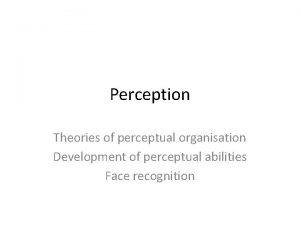Definition Attention is the perceptual processing of selected














- Slides: 14


Definition • Attention is the perceptual processing of selected inputs for inclusion in our conscious experience, or awareness, at any given time. We do not react equally to all stimuli that impinge upon us; we focus upon only a few. In other words, this perceptual focusing is called attention. • Concentration is the ability to sustain attention for a specific period, on a particular object or subject.

Factors Facilitating Attention • External Factors • There are many external factors, which attract our attention more easily than other stimuli. The features that call for selection of focus of attention are stimuli, which are of higher intensity, like loud music, or lecture delivered with microphone. • Stimuli of larger size generally arouse attention, thus you would experience that in seminars or conferences emphasis is placed on bold and large lettering for audiovisual presentation. • Contrast and novelty are other characteristics of the stimuli, which easily catch attention. • Repetition and movement of stimuli are also used by the media to facilitate attention, as moving objects are more attended to, as when compared to static objects.

Internal Factors • The internal factors are those present within the individuals that cause them to attend to one event instead of other. • ‘motive’ or need, if you want to buy a car, your attention would go more easily on advertisements related to selling of cars, similarly if you are hungry, you attend more to the eating places. • Preparating set, i. e. a person’s readiness to respond to one kind of sensory input, but not to other kinds, is another factor, which determines attention. • Interest, also influences the selectivity of attention.

Types of Attention • Selective Attention • Our ability to attend one main event whilst being remotely conscious of others provides us with the paradox of how attention can be both a selective and a divided process simultaneously. • The restriction of mental processing to one event at a time is called ‘selective attention’. • This type of attention provides the means by which we reduce the workload on our mental systems.

Types of Attention • Divided Attention • It is our every day experience that we are able to divide our attention between two or more events or tasks, such as listening to music while studying, knitting while watching television, or engaging in conversation while driving. • Kahneman (1973) proposed the ‘resource allocation’ theory of attention. ’ Resources’ refer to a reservoir of mental energy from which is drawn the appropriate amount when dealing with specific tasks. The more difficult the task, the greater will be the demands of the mental resources required to complete it. The less energy one particular task demands then the more of that energy will be available for allocation to other things being done simultaneously. • Our capacity for dividing attention between tasks increases with practice on them. • It has been suggested that our mental resources do not have limited capacity but may actually expand with practice. It may, therefore, be possible to develop our cognitive resources in more efficient ways, once the principles are more clearly understood.

Types of Attention • Sustained attention or vigilance is required to process stimuli of long duration. Sustained attention underlies the capacity to detect a signal over long periods • for example to inspect a screen and report when a signal appears. • Sustained attention can be assessed on continuous performance test. • The test consists of rapidly presented set of task with varied spacing and timing of target and nontarget stimuli.

Automatic and Conscious Processing • Compare a person who has been driving for long to that of a novice. One notices that after acquiring the skill a person can drive and converse or listen to the music at the same time, whereas the novice will have to put in all his mental resources in driving, e. g. his concentration on the road, on the steering wheel, accelerator, brakes, etc. • This fundamental difference between our ability to perform a complex task as a beginner and later as a skilled person is that of degree of mental effort involved. The way that a skilled person applies a little effort in order to perform a task fluently is a source of constant frustration to the struggling novice. Skilled performance seems to require few cognitive resources such as that involving attention to detail.

Automatic and Conscious Processing • Shiffrin and Schneider (1977) proposed that attention occurred in two domains, which they named ‘dom A’ and ‘dom B’. Dom A processing describes general, undivided attention, the features of which are that it is passive, automatic, has a relatively large capacity and makes a multilevel analysis of the attended information. • Conversely, dom B processing is consciously controlled and is an active system having limited capacity and having no control over the processing that occurs in dom A. The dom A system continuously receives input about the environment that it processes unconsciously. • Tasks that are well learnt have their elements stored in long-term memory, so they are available during the automatic processing of events when such tasks are subsequently performed.

Clinical Applications • Attention and concentration are the psychological processes, which are the first to get affected in illness and especially in psychiatric disorders. The patients with schizophrenia exhibit deficits in attention, which is evident even from the casual clinical contact with these patients. • Some schizophrenics lack the capacity to perceive and respond to situations objectively, due to their inability to achieve a major ‘set’. The schizophrenic is characterised by segmental set, in which response preparation is compromised due to an inappropriate focus on minor or irrelevant aspects of the stimulus array. The attentional deficits in schizophrenic have been assessed on immediate serial recall tasks, span of apprehension, reaction time, dictomic listening, backward masking and continuous performance tests.

Clinical Applications • Undue preoccupation with memories of recent and/or past events associated, for example, with bereavement, an anxiety state or a depressive disorder, results in diminished attention to the external world, so that information is not registered and the individual becomes forgetful and unable to pursue a task requiring sustained attention such as reading. In some patients who complain of physical symptoms for which no organic cause can be discovered, it is probable that their complaints are, at least in part, due to an excessive focussing of attention on the site of the symptom and that what they are experiencing is a bodily sensation which does not normally reach the level of awareness.

Clinical Applications • Just as in some patients input may be selectively enhanced, so in others it may be blocked for psychological reasons. There are patients who, though free from organic disease, present with a loss of skin sensation in part of the body, or of a special sense such as vision or hearing. Such complaints usually do not correspond with those produced by organic disease and they are commonly described as hysterical. It has for long been suggested that the mechanism by which they occur is a process of involuntary dissociation between a limited part of consciousness (e. g. that concerned with skin sensation from a particular area or with visual or auditory perception) and the rest of consciousness. Thus these parts are dissociated or shut off from the rest of awareness and the individual no longer experiences the appropriate sensations or perceptions.

Clinical Applications • Some of the phenomena produced by hypnosis may be related to alterations of attention, and indeed the fundamental basis for the process may be a highly selective focussing of attention by the subject on the hypnotist with a corresponding lowering of attention to all other stimuli. Thus in a suitable subject the hypnotist is able to suggest a selective inattention to particular stimuli, resulting in, for example, an area of skin anaesthesia or a loss of a special sense such as vision or hearing. • Diseases affecting the brainstem (i. e. including the reticular formation), such as inflammation (e. g. encephalitis lethargic or sleeping sickness) or pressure from a tumour, can cause drowsiness, sleep or complete loss of consciousness. • Conditions affecting the functioning of the brain more generally (e. g. through lack of oxygen or blood supply) may cause a state of delirium, with impairment or ‘clouding’ of consciousness; the patient may become confused, or disoriented— not knowing the present time or place and hallucinated, may have difficulty in concentration and subsequently have little or no memory for events at the time.

Clinical Applications • Finally, episodes of unconsciousness occur in some forms of epileptic seizure, a condition associated with an electrical discharge in the brain which, in some individuals, ‘epileptics’, arises spontaneously from time-to-time, but can be provoked in anyone by chemical or electrical means (e. g. electroconvulsive therapy or ECT). • Attention deficit hyperactive disorder is a common clinical condition in children. This disorder has onset before seven years of age, is four to five times more common in boys than girls. Attention disturbances are manifested as failing to finish the tasks that were started, easy distractibility, and difficulty in tasks requiring sustained attention. • Children with poor attention may have average intelligence yet their school performance is very poor. These children often have comorbid problem of conduct disorder or specific learning disability.
 Michelle benjamin phd
Michelle benjamin phd A perceptual set refers to
A perceptual set refers to Difference between formal and functional region
Difference between formal and functional region Perceptual set psychology definition
Perceptual set psychology definition Formal region example
Formal region example Phi phenomenon psychology definition
Phi phenomenon psychology definition Perceptual set
Perceptual set Perceptual region definition
Perceptual region definition Spatial interaction ap human geography
Spatial interaction ap human geography Plumbing en español
Plumbing en español Top down procesing
Top down procesing Gloria suarez
Gloria suarez Bottom up processing
Bottom up processing Neighborhood processing in image processing
Neighborhood processing in image processing Primary and secondary processing of food
Primary and secondary processing of food
